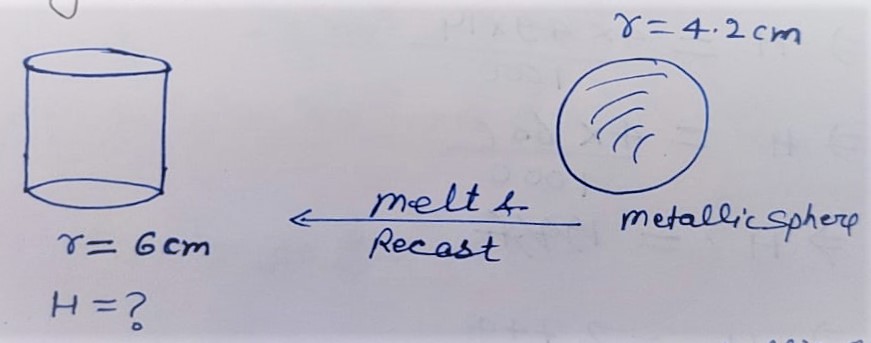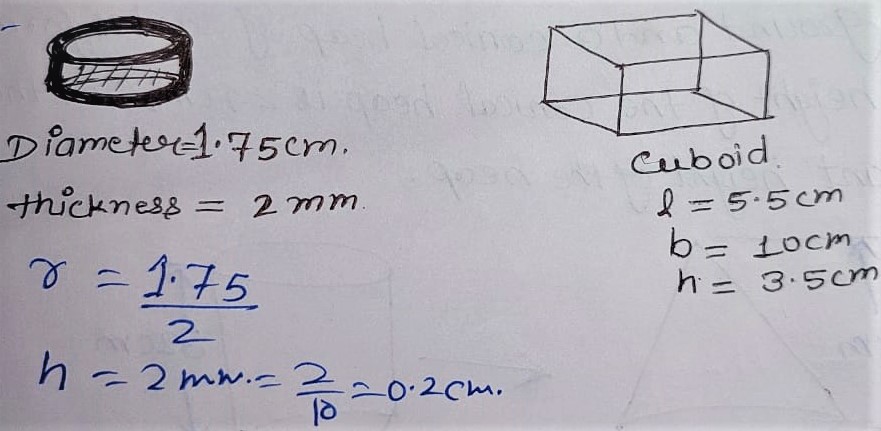Q.1 A metallic sphere of radius 4.2 cm is melted and recast into the shape of a cylinder of radius 6 cm. Find the height of the cylinder.
Solution:

Volume of cylinder = Volume of metallic sphere
⇒ πr²H = 4/3 × πr³
⇒ 6²H = 4/3 × (4.2)³
⇒ H = 4/3 × 42/10 × 42/10 × 42/10 × 1/6 × 1/6
⇒ H = 4× 49 × 14 / 1000
⇒ H = 2744 / 1000
⇒ H = 2.744 cm
Hence Height of Cylinder H = 2.744 cm
Q.2 Metallic spheres of radii 6 cm ,8 cm and 10 cm , respectively are melted to form a single solid sphere. Find the radius of the resulting Sphere.
Solution:

Let
r1 = 6 cm
r2 = 8 cm
r3 = 10 cm
Radius of new solid = R
V1 + V2 + V3 = V
⇒ 4/3 πr³1 + 4/3 πr³2+ 4/3 πr³3 = 4/3 πR³
⇒ 4/3 π [ r³1 + r³2+ r³3 ] = 4/3 πR²
⇒ r³1 + r³2+ r³3 = R³
⇒ 6³ + 8³+ 10³ = R³
⇒ 216 + 512+ 1000 = R³
⇒ 1728 = R³
⇒ ³√1728 = R
⇒ ³√12×12×12× = R
⇒ 12 = R
Hence Radius of Resulting Sphere R = 12 cm.
Q.3 A 20 m deep well with diameter 7 m is dug and the earth from digging is evenly spread out to form a platform 22 m by 14 m. Find the height of the platform.
Solution:
Diameter of well = 7 cm
r = 7/2
Depth(H) = 20 m
Dimension of platform:
length (l) = 22 m
breadth(b) = 14 m
height (h) =?
Volume of platform = Volume of earth dug out from the well which is in cylindrical shape
⇒ l × b × h = πr²h
⇒ 22 × 14 × h = 22/7 × 7/2 × 7/2 × 20
⇒ h = (11×10×7 )/ (22×14)
⇒ h = 2.5 m
Hence Height of platform = 2.5 m
Q.4 A well of diameter 3 m is dug 14 m deep. The earth taken out of it has been spread evenly all around it in the shape of a circular ring of width 4 m to form an embankment. Find the height of the embankment.
Solution:
Dimension of Well
Diameter = 3 m
r = 3/2 m
Deep (H) = 14 m
Dimension of Platform(in ring shape):
r = width = 4 m
h =?
Volume of platform = Volume of earth dug out from well
πr²h = πR²H
⇒ r²h = R²H
⇒ 4×4 × h = 3/2 × 3/2 × 14
⇒ h =( 3 × 3 × 14 )/(2×2×4×4)
⇒ h = 63 / 32
⇒ h = 1.96 m
Q.5 A container shaped like a ring circular cylinder having diameter 12 cm and height 15 cm is full of ice-cream. The ice-cream is to be filled into cones of height 12 cm and diameter 6 cm, having a hemispherical shape on the top. Find the number of such cones which can be filled with ice-cream.
Solution:
Volume of each ice-cream cone = Volume of cone + volume of hemisphere
⇒ Volume of each ice-cream cone = 1/3 πr²h + 2/3 πr³
⇒ Volume of each ice-cream cone = 1/3 × πr² [ h + 2 r ]
⇒ Volume of each ice-cream cone = 1/3 × π 3×3 [ 12 + 2×3 ]
⇒ Volume of each ice-cream cone = 1/3 × π 3×3 [ 12 + 6 ]
⇒ Volume of each ice-cream cone = 3π × 18
Number of Cones = Volume of Container/ Volume of Each Cone
⇒ Number of Cones = πr²h/ 3π×18
⇒ Number of Cones = π×6×6×15/ 3π×18
⇒ Number of Cones = 2×5
⇒ Number of Cones = 10
Hence Total Number of Cones Required = 10
Q.6 How many silver coins, 1.75 cm in diameter and of thickness 2 mm must be melted to form a cuboid of dimension 5.5 cm × 10 cm × 3.5 cm.
Given:

Dimension of silver coin:
Diameter = 1.75 cm
Thickness = 2 mm
r = 1.75/2
h = 2 mm = 2/10 = 0.2 cm
Dimension of cuboid:
l = 5.5 cm
b = 10 cm
h = 3.5 cm
To Find:
Number of coins=?
Solution:
Number of coins = Volume of cuboid / Volume of one coin
⇒ Number of Coins = l × b × h / πr²h
⇒ Number of Coins = (5.5 × 10 × 3.5 )/ (22/7 × 1.75/2 × 1.75/2× 0.2)
⇒ Number of Coins = 10×4×10
⇒ Number of Coins = 400
Hence Total number of coins required to melt = 400
Q.7 A cylindrical bucket, 32 cm high and with radius of base 18 cm, is filled with sand. This bucket is emptied on the ground and a conical heap of sand is formed. If the height of the conical heap is 24 cm, find the radius and slant height of the heap.
Solution:

Volume of conical heap = Volume of cylindrical bucket.
⇒ 1/3 πr²h = πr²h
⇒ 1/3 × πr²×24 = π(18)²×32
⇒ 8 r² = 18×18× 32
⇒ r² = 18×18×32/8
⇒ r² = 18×18×4
⇒ r = √18×18×4
⇒ r = 18×2
⇒ r = 36 cm
Slant Height( l )= √r²+h²
⇒ l = √(36²+24²)
⇒ l = √(1296+576)
⇒ l = √(1872)
⇒ l = √2×2×2×2×3×3×13
⇒ l = 2×2×3×√13
⇒ l = 12√13
Hence radius = 36 cm
Slant height = 12√13 cm
Q.8 Water in a canal, 6 m wide and 1.5 m deep , is flowing with a speed of 10 km/hr ,How much area will it irrigate in 30 minutes, if 8 cm of standing water is needed ?
Given:
Speed = 10 km/hr
In 1hour = 60 minutes water flows = 10 km
∴ in 1 minute water will flow = 10/60 km
∴ in 1 minute water will flow = 10/60 ×30 = 5 km=5000 m
Volume of field = volume of water flows in 30 minutes
⇒ Area of field × h = 6×1.5×5000
⇒ Area of field × 8/100 = 6×1.5×5000
⇒ Area of field = 6×1.5×5000 ×100/8
⇒ Area of field = 3×15×2500×5
⇒ Area of field = 45×2500×5
⇒ Area of field = 562500 m²
⇒ Area of field = 56.25 hectares [ 10000 m² = 1 hectares ]
Q.9 A Farmer connects a pipe of internal diameter 20 cm from a canal into a cylindrical tank in her field , which is 10 m in diameter and 2 m deep. If water flows through the pipe at the rate of 3 km/h , in how much time will tank be filled.
Given:
Dimension of pipe:
Diameter = 20 cm
Radius (r) = 20/2 = 10 cm = 10/100 = 1/10 m
Dimension of tank:
Height (h) = deep = 2 m
Diameter = 10 m
r = 10 / 2 = 5 m
Speed of water = 3km/ hr
in 1 hour = 60 minutes water flows = 3 km
∴ in 1 minute water will flow = 3×1000/60 = 50 m
Total time taken to fill the tank = Volume of tank / Volume of water flows through pipe in 1 minute
⇒ Total time taken to fill the tank = πr²h / πr²h
⇒ Total time taken to fill the tank = 5²×2 / 0.1²×50
⇒ Total time taken to fill the tank = 5×5×2 / 0.1×0.1×50
⇒ Total time taken to fill the tank = 5×5×2×10×10/ 1×1×50
⇒ Total time taken to fill the tank = 5×5×2×2
⇒ Total time taken to fill the tank = 100 minutes
